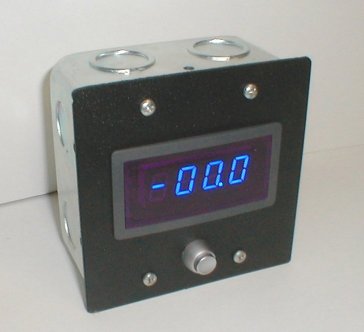Digital Amp Panel Meter
With two gang switch box and shunt
100 Amp DC Digital Blue LED Display
With On/Off switch
Finally an affordable, ready to go amp meter for your alternate energy system.
This meter does not need a separate power supply
A highly-efficient yet flexible amp meter which can be used to measure the charge or discharge current in 12, 24 and 48 volt alternate energy systems or other energy sources or loads. No separate power supply is needed! This meter has been designed specifically for alternate energy systems; yet, it also perfect for measuring vehicle, yacht, electric toy, tool or motorcycles having a 12V, 24V or 48V storage batteries.
Advantage over other panel meters by competitors:
- Compared with LCD panel meters, this LED panel meter has a high contrast display with super clear numbers and wide viewing angle.
- Measures Amps to or from a battery bank, energy source or load. (Both positive or negative flow)
- Super convenient operation (DOES NOT need an additional power supply.) Hook up the leads and you are set.
- On/Off Switch -- This meter uses only 30ma to 60ma ( .03 to .06 amps) at 24 volts, or approx. 10ma at 48 volts. If you are like many of us who simply do not like wasted energy, regardless of how small it is, then you will love this meter, as you can simply shut if off when you are not using it.
- Good looking, black matte solid metal face plate
- Shunt is remotely located for direct sensing. This allows the current carrying wires to take a more direct path to the batteries and alleviates the need to route them through the meter case.


The 100 amp shunt is included, but not shown.
Features:
- Large (0.56”/14.2mm) easy-to-read blue LED display.
- Wide application range. Can be used to measure the voltage of various batteries ranging from 7.5 to 100VDC.
- Successive approximation-based AD conversion, which is fast and accurate.
- Highly-efficient DC-DC converter, with very low temp rise.
- Completely isolated, super efficient, custom made switch mode power supply.
- Reverse polarity protection..
Specifications:
- Min Input voltage : 8.5vdc
- Max Input voltage: 100 volts.
- Max Amperage: 100 Amps DC
- 4.2" (W) x 4.2" (H) x 2.2" (D)

The diagram above is from our dual meter series. This single amp meter uses the same internal power supply, so hookup instructions are the same, however there is no voltage measurement.
There is a big difference in this unit's internal power supply and the ones you will see being advertised for powering panel meters.
- Most "meter" supplies you find use a low cost linear voltage regulator. This is completely useless for 48 volt systems, and on 24 volt systems, you better have a big heat sink and expect to use about 1 amp of power just running a single meter. This supply uses a super efficient high voltage switching regulator, this is not cheep, but it is necessary!
- An amp meter requires total isolation from its power supply verses its sense leads. This is difficult to accomplish when you want to use the voltage available at the shunt to power the meter directly. Many DC to DC isolators are available if you wanted to build this type of supply yourself, but then you still have to reduce the incoming voltage to the level of the DC to DC isolator -- and you have to prevent the meters power demand from dropping the voltage across the shunt and fooling the amp meter into thinking there is more amperage then is actually occurring. A voltage drop of only .0075v will cause an amp reading of 10 amps!. We have accomplished this and it is ready to go.
- This supply uses a super efficient pre-regulator to allow higher than normal incoming voltages to properly handle 48 volt systems in an overcharged state or that are receiving high incoming charge voltages. This you will not find (that we are aware of) anywhere for any direct powered meter in this price range.
- You can change a jumper to cause the volt meter to measure the voltage at the shunt, or the voltage of the supply (battery voltage).
Hookup four wires and you are ready to go. Push the switch to turn the meter on. Push again to shut if off. That's about it, super simple, yet super functional!

Click image to enlarge.
Click here to download the manual
|









